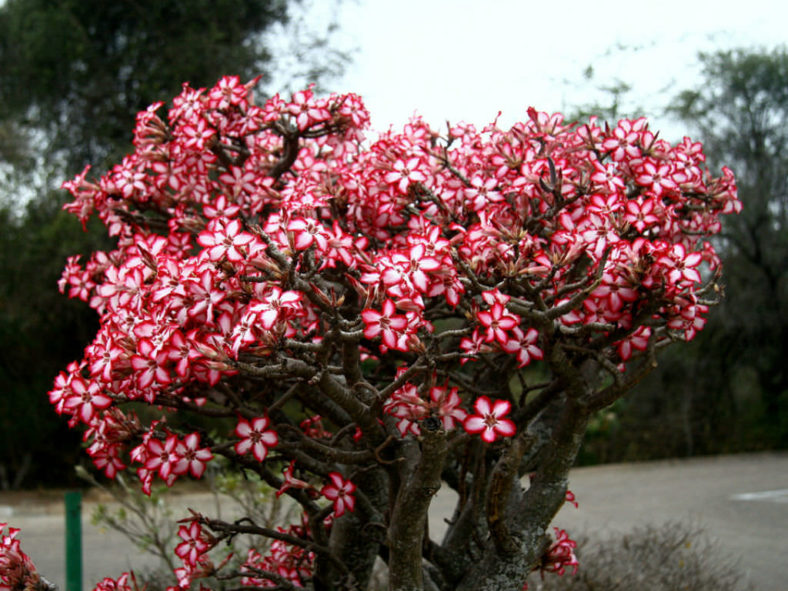Scientific Name
Adenium multiflorum Klotzsch
Common Name(s)
Impala Lily, Sabi Star, Kudu Lily
Synonym(s)
Adenium obesum subsp. multiflorum, Adenium obesum var. multiflorum
Scientific Classification
Family: Apocynaceae
Subfamily: Apocynoideae
Tribe: Nerieae
Subtribe: Neriinae
Genus: Adenium
Origin
The native range of Adenium multiflorum is from southeastern Zambia and Malawi, through Zimbabwe and Mozambique to South Africa and Eswatini. It grows in dry lowveld woodland among rocks or on sandy slopes and flats.
Description
Adenium multiflorum, also known as Adenium obesum subsp. multiflorum, is a succulent shrub or small tree with branched stems that arise from a large carrot-like root. It can grow up to 10 feet (3 m) tall and has a toxic milky latex in the bark and fleshy parts of the stems. The bark is shiny grey to brown. Most of the year, the plant does not have leaves and flowers. The leaves usually appear after the flowers. They are smooth, shiny green above and paler below, usually much broader towards the tip, measuring up to 5 inches (12.5 cm) long and 3 inches (7.5 cm) wide.
The flowers are pink to white, red-striped within the throat, and have five lobes with deep pink to scarlet margins. They can reach a diameter of 2.8 inches (7 cm) and appear in terminal inflorescences in winter. The fruits are paired follicles that range from pale grey to pale grey-brown and can reach 7.2 inches (18 cm) in length and 0.6 (1.5 cm) in diameter. The seeds are dirty white to light brown with a tuft of silky hairs.

Hardiness
USDA hardiness zones 10b to 11b: from 35 °F (+1.7 °C) to 50 °F (+10 °C).
How to Grow and Care
These are not difficult plants to grow well, provided they get enough sunlight and warmth. However, like all succulents, they cannot tolerate sitting in water, and if you err, do it on the side of too little water. Use a specialized soil mix designed for cacti and succulents.
Repot as needed, preferably during the warm season. To repot a Desert Rose, ensure the soil is dry before repotting, then gently remove the plant from the pot. Knock away the old soil from the roots, removing any rotted or dead roots. Treat any cuts with a fungicide and antibacterial solution. Next, place the plant in its new pot and backfill with potting soil, spreading the roots out as you repot. Leave the plant dry for a week or so, then begin to water lightly to reduce the risk of root rot.
The Desert Rose is typically propagated by seed. If your plant develops a seed pod, sow the seeds as soon as possible after the pod ripens to maximize the chances of germination. Desert Rose can also be propagated from stem cuttings, but this plant often fails to develop the characteristic (and highly desired) bulbous stem.
Links
- Back to genus Adenium
- Succupedia: Browse succulents by Scientific Name, Common Name, Genus, Family, USDA Hardiness Zone, Origin, or cacti by Genus
Photo Gallery
Click on a photo to see a larger version.


